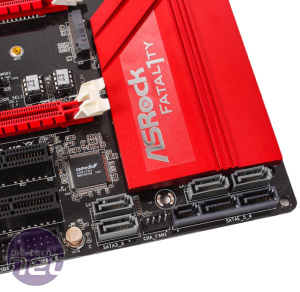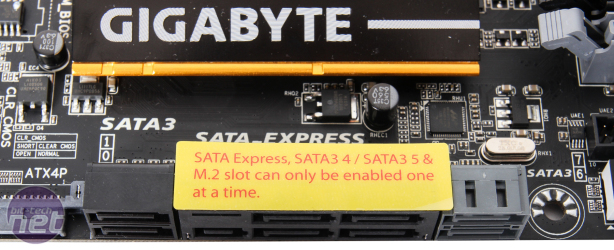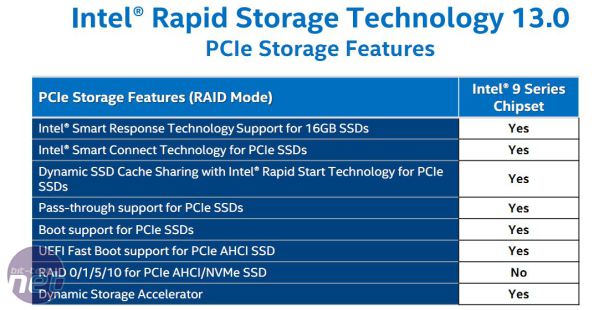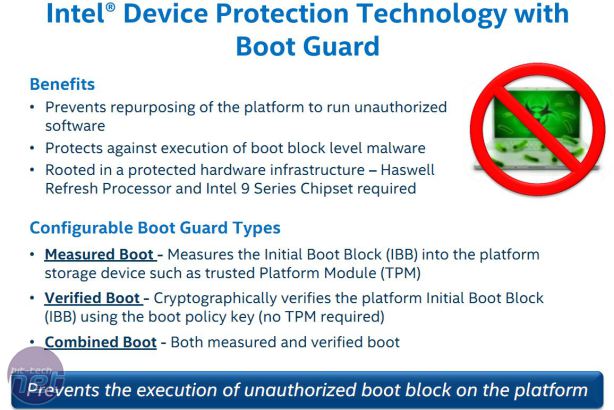The Intel 9-Series Chipsets Examined - New Features
By this point, you might be wondering what's actually new in the 9-Series chipsets other than future CPU support. The main answer, in short, is support PCIe storage, which is enabled by the Intel Rapid Storage Technology 13 (RST 13) driver package that's compatible with both Z97 and H97.

Click to enlarge - The SATA Express and M.2 connectors that you'll find populating 9-Series motherboards
The physical manifestation of this feature will be the availability of SATA Express and/or M.2 connectors on some Z97 and H97 motherboards. The SATA Express connector is something of a hybrid design that uses two standard SATA plugs alongside an additional connector. As the SATA plugs are backward compatible, SATA Express connectors can be used with a single SATA Express device or two legacy SATA ones. By design, SATA Express provides access to only two PCI Express lanes, so on the 9-Series chipsets (which use PCIe 2.0) there's a maximum theoretical bandwidth available to SATA Express devices of 10Gbps, which is 67 percent higher than regular SATA 6Gbps devices have.
M.2 (previously known as NGFF), on the other hand, is intended as a replacement for mSATA. Similar to mSATA and PCIe Mini Card devices, M.2 devices plug directly into the motherboard, making them particularly well suited to portable devices like laptops and tablets. Both SATA and PCIe SSDs can technically be used with the M.2 connector, though typically it will be PCIe only (the SATA and PCIe protocols are not compatible). Unlike SATA Express, the M.2 specification supports up to four PCIe lanes. However, the Intel 9-Series chipsets only provide two lanes, so again the maximum theoretical bandwidth is 10Gbps.
In our experience with 9-Series motherboards so far, we've already seen that the ways manufacturers choose to implement support for M.2 and/or SATA Express varies. However, with only eight PCIe 2.0 lanes available to the Z97 and H97 chipsets to begin with, it's not surprising to see that in most cases the use of a PCIe M.2 or SATA Express device will disable the functionality of other parts of a motherboard (e.g. PCIe x1 slots, certain SATA ports or additional controllers). Therefore, if you do plan on using one, it will be worth checking that other functionality you require won't be lost in the process.
The majority of features found in the RST 13 drivers are applicable to PCIe storage devices, including UEFI Fast Boot, Rapid Start Technology and Smart Response Technology, among others. PCIe devices can also be configured as boot drives, but RAID is not supported in any way – for regular SATA devices, however, RAID 0/1/5/10 is again fully supported, with TRIM also available on RAID 0 SSD set-ups. Also, only the AHCI interface is currently supported, but leaked release notes for the RST 13 driver suggest that the NVMe interface, which is optimised for SSDs, will be supported as of the 13.1 release, though no time frame is indicated.
The final new feature to speak of is Device Protection Technology with Boot Guard. It is essentially a hardware-level feature designed to protect your boot block against malware attacks. Exisiting Haswell processors do not support this feature – you'll need at least a Haswell Refresh CPU along with an Intel 9-Series motherboard in order to benefit from it.
Be sure to check out our Z97 motherboard round-up, featuring ASRock, Asus, Gigabyte and MSI.

MSI MPG Velox 100R Chassis Review
October 14 2021 | 15:04













Want to comment? Please log in.